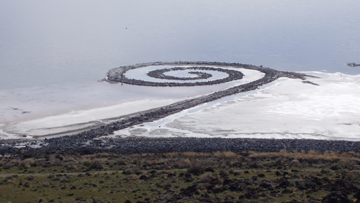
Robert Smithson, "Spiral Jetty," 1970
When I first saw that this site’s new Flash Points topic was Art and the Environment, I immediately thought of two artists: Robert Smithson and Eames Demetrios. They are not contemporaries. Smithson, a seminal land art pioneer, died tragically in the height of his career in 1973. Demetrios, a currently active artist and filmmaker, is the namesake of his designer grandparents, Charles and Ray Eames. Demetrios is creating an elaborate global installation called Kcymaerxthaere, a manifestation of what he calls “3-dimensional story telling.” These two artists provide compelling arguments for the value of natural resources precisely because neither deals with the topic directly. Rather, both engage in a form of artistic practice that stretches back to prehistory. By creating monuments to complex mythologies and situating them in both a physical and historical context, the apparent value of these sites is renewed.
Robert Smithson is most famous as an early proponent of the land art movement. His most famous work, Spiral Jetty (1970), is a 1,500 foot curled protrusion into a remote part of the Great Salt Lake in Utah. It’s made of truckloads of basalt rock, salt, and earth. It’s easy to mistake Smithson as simply a precursor to someone like Andy Goldsworthy. While Goldsworthy’s earthworks draw attention to the beauty of the site with delicate and sensible interventions, Smithson’s approach was not nearly so tidy. Smithson was fascinated by entropy, the unstoppable loss of energy, and increase of chaos, within natural systems. Far from a zen-like harmony with nature, Smithson’s interactions with the natural world hinted at an apocalyptic tension. For an example of a very un-Goldsworthy Smithson work, check out Glue Pour (Vancouver, 1969).
In the case of Spiral Jetty, Smithson’s intervention in the landscape manages to inspire compassion for the natural world despite his sometimes brutal approach. Smithson selected the site for its pinkish red water. In an essay about the work, he explains, “Chemically speaking, our blood is analogous to the primordial seas. Following the spiral steps we return to our origins, back to some pulpy protoplasm, a floating eye adrift in an antediluvian ocean.”
Smithson was intent on situating Spiral Jetty not only at a specific site in Utah, but also within the epic sweep of geologic time. In a film he made to document the piece, he intercuts a map of the Jurassic Period, about which he said, “I needed a map that would show the prehistoric world as coextensive with the world I existed in.” This is where I find a clear connection to the recent work of Eames Demetrios. As I mentioned earlier, Demetrios is six years in to a global series of site-specific installations known as Kcymaerxthaere. Kcymaerxthaere consists of a series of sculptural installations and faux historical bronze plaques, each one telling a portion of a story about a fantasy world that parallels our own. It’s a bit like trying to read a Tolkien novel spread out across 63 sites in ten countries, in locations as diverse as the Australian outback and the bottom of the ocean off the coast of Scotland.
Demetrios describes himself as a “geographer at large,” and speaks about the project more in terms of discovery than creation. I had the chance to meet Demetrios when he came to Grand Rapids, MI, to install five permanent Kcymaerxthaere plaques as a part of ArtPrize, an international art event I help manage. As with many artists who have installed works in Grand Rapids, Demetrios’s mythical plaques deal primarily with the Grand River, which divides the city in half. The plaques are sited at two local universities, two city parks, and a bar, and each tell of “Grwosts,” specialized Kcymaerxthaere denizens that act as time guides, leading people over the tremendous temporal rift of the River Lakcenne (what we call the Grand River).
Eames Demetrios, "Kcymaerxthaere," 2003
While touring Demetrios’s plaques is certainly fun, and has value as an act of civic engagement or even a twist on geocaching, the real value lies in the plaques’ ability to impart a sense of importance on a site by tethering it to myth. The plaque in Grand Rapids that does the best job of this is titled “Handfuls of Small Stones.” It is situated on a boardwalk on the east bank of the Grand, literally inches from the water. It tells of a Kcymaerxthaere ritual that takes place on the parallel of that site, in which handfuls of small stones are tossed in the water. Demetrios has provided a box of pebbles so that visitors can participate in this ceremony, where the thrower acts out the creation story of Kcymaerxthaere. The text explains, “the passage of rock into immersion could symbolize the life of an individual, a community, even what we think of as a planet. Even a pebble could be an “anggroav”, a difficult to translate term referring to the tendency of some islands to be their own universe, with their own laws of time and space.”
Both Smithson and Demetrios marry natural sites with epic mythologies. Creation myths have a particular ability to inspire a sense of awe with the natural world. Demetrios does this with a playful and hopelessly complex web of Tolkien-esque story fragments. Smithson, on the other hand, is concerned with the absolute and unforgiving elements of the natural world, rocks, salt, water. Origins lead naturally into destructions, entropy. In regard to the viewer’s relationship to the natural site, however, the effect is the same. These works remind us that nature is ancient, and we are not. They inspire empathy for the planet’s plight not by pandering for sympathy, but by creating a “fear of god” effect, a reminder that we are blips in a cosmic expanse.



